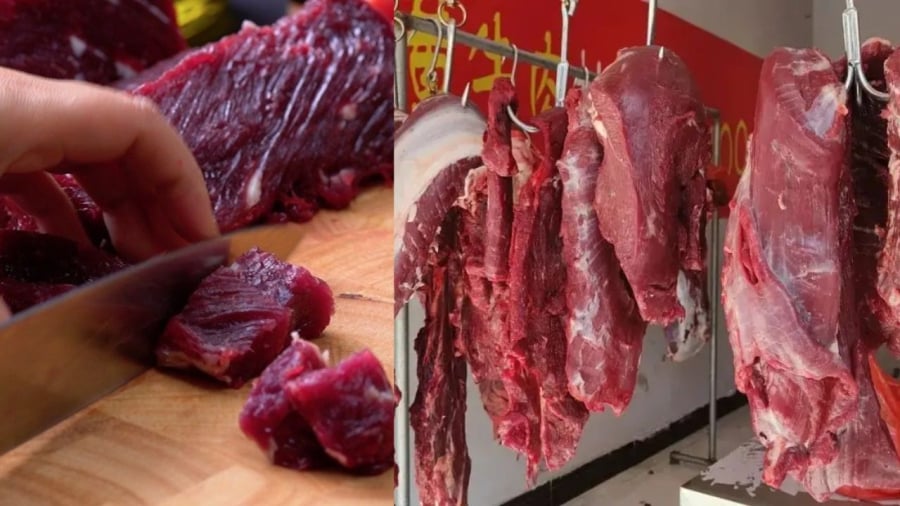Beef is a nutritious food, rich in protein, iron, zinc, and vitamin B12, offering significant health benefits and high nutritional value. However, unscrupulous traders may take advantage of consumers by mixing low-quality beef with better cuts. This adulterated meat could be water-injected, previously frozen, or even chemically treated pork or buffalo meat, leading to a costly and potentially harmful purchase. So, how can one select fresh and safe beef?
1. Identifying Fresh Beef Through Visual Inspection
Color: Fresh beef typically has a bright red color with a slightly darker hue but not an overly deep shade. When cut, the surface should be dry without any liquid oozing out. Pale or abnormally dark red meat could indicate stale or chemically treated beef.
Marbling and fat: High-quality beef has fine, even muscle fibers with distinct marbling. Fat in good beef is usually light yellow or ivory-colored and odorless. If the fat appears unnaturally white or is brittle and easily breakable, it may indicate frozen beef that has been stored for an extended period or beef from a force-fed cow.

2. Detecting Water-Injected Beef
A common scam is injecting water into beef to increase its weight, which is not only commercial fraud but also detrimental to the quality and safety of the meat.
Signs of water-injected beef:
- The meat appears abnormally swollen with an unusually glossy surface.
- When pressed, the meat feels soft and spongy, and water may seep out.
- It has a strange, slightly rancid, or foul odor.
- During cooking, it releases excessive water, resulting in bland and chewy meat.
Simple test: Press the meat with your fingertip. If you notice excessive water seepage and the indentation doesn’t bounce back, it’s likely water-injected.
3. Avoiding Long-Frozen Beef
While frozen beef isn’t inherently bad if properly stored, much of the beef sold has been frozen for extended periods or thawed and refrozen multiple times, leading to nutrient loss and bacterial contamination. Some traders even pass off thawed meat as fresh.
Signs of poor-quality frozen beef:
- The meat has a brownish or greenish tint.
- It has a thick layer of ice or tiny ice crystals inside, indicating prolonged freezing.
- It lacks elasticity.
- It emits a faint foul odor or a strong rancid smell.
- When cut, it doesn’t stick to the knife and releases water, indicating previous thawing.
- During cooking, it lacks flavor and tends to become brittle and lose its sweetness.
Note: If you intend to buy frozen beef, opt for products from reputable stores with clear labels indicating origin, production, and expiration dates.
4. Tips for Avoiding Chemically Treated Beef
Some suppliers use artificial colors, cleaning agents, or preservatives to enhance and maintain the meat’s color, making it appear appealing even after prolonged storage.
Signs of chemically treated beef:
- Unnaturally bright red color: If the meat has an abnormally bright red color resembling blood, and the shade is uneven, it likely contains industrial dyes.
- Unpleasant pungent or faintly acrid odor: Fresh beef has a mild characteristic scent. Avoid meat with strange smells like bleach or a faint acrid odor.
- Sticky and moist surface: Indicates chemical treatment or improper storage.
- Color change during cooking: If the meat turns dark, shrinks abnormally, or emits a foul odor while cooking, it’s a clear warning sign.

5. Choosing the Right Cut of Beef for Different Dishes
Different parts of the cow are suited for different dishes:
- Grilling or pan-frying: Tenderloin (thăn bò)
- Stir-frying: Shank (bắp bò), rump (mông bò), or shoulder (vai bò)
- Stewing or braising: Tendon (gân bò), oxtail (đuôi bò), or brisket (nạm bò)
- Hot pot: Chuck flap (ba chỉ bò) or flank steak (diềm thăn)
- Tip: When choosing beef for stir-frying, select cuts with some marbling, as this will keep the dish tender and moist.
Additional Tips for Selecting Beef
- Avoid meat with strange odors, slimy surfaces, or bruising, indicating spoilage or improper storage.
- Be wary of meat that is too soft or too hard, as this could be a sign of water injection or prolonged freezing.
- Always check the expiration date and storage conditions when buying packaged beef.
- Observe how the butcher slices the meat; fresh beef should stick to a sharp knife.
- When given a choice, select meat hung higher up, as it’s less likely to be water-injected and will be drier.
Choosing fresh and safe beef not only enhances the taste of your dishes but also ensures the well-being of your family.






























